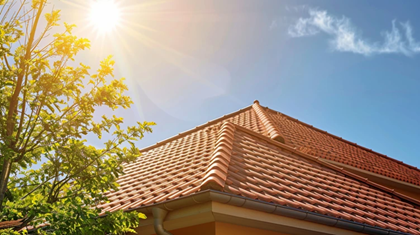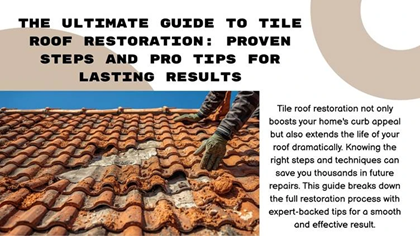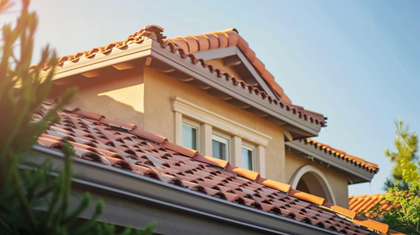Tile Roof Restoration: Step-by-Step Process and Expert Tips
Tile roofs are known for their beauty and durability. They give homes a classic look and can last for decades if properly cared for. But even the strongest tile roofs need a little help over time.

Weather, age, and small damages can affect both the appearance and the performance of your roof. That’s where restoration comes in—it’s a smart way to extend your roof’s life without replacing the whole thing.
In this article, you’ll learn exactly how tile roof restoration works, step by step. We’ll break it down in a simple, no-nonsense way. Whether you’re a homeowner thinking ahead or someone who’s already spotted signs of wear, these expert tips will help you understand the process and make confident choices.
Why Choose Restoration Instead of Replacement
Tile roof restoration is a popular choice for a good reason—it’s far more affordable and less invasive than a full roof replacement. If the structure underneath is still solid and the tiles themselves are mostly intact, restoration can bring your roof back to life. It fixes leaks, renews appearance, and strengthens the surface against future damage. This option also helps maintain the charm of older homes where replacing the tiles might not be ideal. In many cases, homeowners are surprised by how much better their roof performs after a full restoration. Rather than ripping everything out, restoration allows you to preserve the existing materials while updating the roof’s durability and look. Read more on this topic here: https://medium.com/@Darren_Cormack .
Signs Your Tile Roof Needs Restoration

Before you begin any restoration work, it’s important to know when your roof is ready for it. A few signs might be visible from the ground, while others may need a professional inspection. The good news is that tile roofs are pretty open about telling you when they need some care. Look out for discolored areas, broken or sliding tiles, or evidence of moss and mold. These signs show that the roof isn’t draining water properly anymore. You may also notice water stains in your ceiling or attic after rain. These early clues can save you money and stress if caught in time.
Top 5 signs your tile roof needs restoration:
- Cracked or broken tiles
- Water stains on ceilings or in the attic
- Mold or moss growing between tiles
- Tiles slipping out of place
- Faded or chalky surface color
Once you notice any of these issues, don’t wait too long. Letting damage sit will only make repairs more expensive. A qualified roofer can assess the condition and tell you if restoration is the right path. It’s better to restore early than replace too late. Discover related insights in this article: https://issuu.com/kompaqroofing.com.au .
The Step-by-Step Tile Roof Restoration Process

Restoring a tile roof isn’t just a quick clean-up job—it’s a detailed process that brings old roofs back to life. Professionals follow a proven system to make sure your roof not only looks better but also performs better. First, they start with a full inspection. Every tile is checked for cracks, loose fit, or damage. Then the roof is cleaned thoroughly—usually with a pressure washer—to remove dirt, mold, and old paint or sealant. After that, damaged tiles are repaired or replaced, ridge capping is re-bedded, and all gaps are sealed to keep moisture out. The final step includes applying protective coatings that help the tiles resist water, UV rays, and dirt buildup in the future. Each of these stages is key to restoring both function and appearance.
Benefits of Restoring vs. Replacing a Tile Roof
There are many reasons why restoration might be the smarter choice. The most obvious is cost—restoring a roof can be 40–60% cheaper than full replacement. Restoration is also quicker and creates less mess around your home. Since tiles are often made from durable materials like clay or concrete, there’s no need to replace them if they’re still structurally sound. Restoration focuses on improving performance and preventing future damage rather than starting from scratch. It’s also more eco-friendly, reducing landfill waste and the need for new raw materials. For homeowners looking to improve both appearance and function without breaking the bank, restoration is often the perfect fit. Learn more in this useful post: https://www.keepandshare.com/doc9/32103/kompaq-roofing-in-adelaide-how-the-company-handled-a-roof-replacement .
Now Let’s Compare Popular Tile Roofing Materials

To understand your restoration options better, it helps to know what kind of tile your roof uses. Here’s a helpful breakdown of common tile materials, how long they last, and what kind of maintenance they typically need:
| Tile Type | Lifespan | Maintenance Needs |
| Clay Tiles | 50–100 years | Medium to High |
| Concrete Tiles | 40–75 years | Medium |
| Slate Tiles | 75–150 years | Low to Medium |
| Terracotta Tiles | 50–100 years | Medium |
| Composite Tiles | 30–50 years | Low |
| Fiber Cement Tiles | 40–60 years | Medium |
As you can see, most tile types are long-lasting. Restoration gives them the refresh they need to keep going strong. Knowing your tile material also helps you plan ahead for any future repairs or sealant applications.
Expert Tips for a Long-Lasting Restored Roof
Once your tile roof is restored, you want those results to last as long as possible. The good news is, with a few simple maintenance habits, you can protect your investment for many more years. Start by scheduling an annual roof inspection, especially before winter or rainy seasons. Cleaning your gutters regularly helps prevent water from backing up onto the roof. If you notice new damage, address it quickly—one cracked tile can let in water that spreads to the wood underneath. It’s also smart to keep trees trimmed away from your roofline. Falling branches and accumulated leaves are bad news for tile. Finally, avoid walking on your roof unless absolutely necessary. Tile can be brittle, and unnecessary foot traffic often leads to new damage.
6 Expert Tips to Keep Your Restored Roof in Top Shape:
- Get your roof inspected once a year
- Keep gutters clean and flowing
- Fix cracked or loose tiles promptly
- Trim overhanging trees and branches
- Watch for signs of mold or moss
- Avoid walking on tiles to prevent breakage
With these steps, you’ll not only protect your restored roof—you’ll extend its lifespan dramatically. A little care goes a long way when it comes to keeping tile roofs in great condition. And remember, if you’re ever unsure, a quick call to your roofer can save you from bigger issues later.
Restoring a tile roof is one of the smartest ways to protect your home and boost its curb appeal without the cost of a full replacement. Whether your roof is decades old or just showing signs of wear, restoration gives it a second life. The process is detailed but straightforward—from inspection and cleaning to sealing and coating. By choosing restoration, you save money, reduce waste, and keep the original beauty of your home intact. With the right team and a little maintenance, your restored tile roof can last for many more years. Don’t wait until the damage gets worse—if your roof is ready, give it the care it deserves. You’ll be surprised how much of a difference a professional restoration can make.



